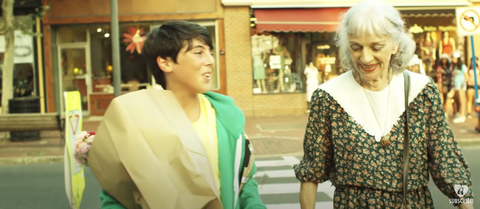
Here are some whole-group or school-wide ideas to foster kindness in your programs:
- Create a kindness rock garden
I am loving this set from FaveCrafts.
I also love how this school created a character out of theirs!

- Have a kindness fashion show during which everyone shows up as their superpower (e.g., Comedy Kid, Manners Man, Door-Opener Darian, etc.)
- Play Kindness Bingo (for free)
- Inspired by this initiative in Baltimore, ask your local coffee shop for a class set of cup sleeves and have students decorate them with kind, uplifting messages
- Create a Kindness Chain – Every student adds a link with a kind act written on it, growing throughout the week.
- High-Five Hallway – Set up a hallway where students give high-fives, fist bumps, or compliments.
- Chalk the Walk – Use sidewalk chalk to write uplifting messages around the school.
- Post-It Positivity – Stick kind messages on lockers, desks, or mirrors.
- Morning Kindness Affirmations – Start each day with a kindness-focused affirmation.
- Have students bring in small items (notebooks, balloons + flour to make stress balls, bubbles, etc.) to assemble regulation kits for local youth mental health organizations.



A child’s superpower is their ability to learn through observation so the number one action that we could take to foster a kind, inclusive environment is to do so by modeling. I loved connecting emotional intelligence to community circles.
![]()
“I feel happy today because I met someone new! I helped them carry out their groceries and felt good that I was able to do that for them.”
“I felt sad today for a friend whose dog has run away.”
"I felt my heart beating fast when I knew my big work presentation was coming up. I think my body was telling me that I was nervous, so I watched some funny videos to try and relax."
Students are then invited to share their own experiences, which can bring up a multitude of ways to help, that some children might not have even considered!
Pro tip: You can extend the community circle, by having students write their idea on a sticky note to add to an Acts of Kindness anchor chart. I would add Kind to Self, Kind to Others and Kind to the Planet columns.

Random Acts of Kindness Day - 17 February
Pay It Forward Day - 28 April
World Kindness Day - 13 November
There are so many opportunities to have fun with random acts of kindness but it can be overwhelming to come up with ideas. I suggest this FREE random acts of kindness challenges that you can customize to best fit your program and instil a sense of excitement for each daily, weekly or monthly challenge.
Click the image below to grab this freebie

Empathy is at the core of random acts of kindness as it presents the why behind the actions. Intentionally carving out time to recognize and sit with these emotions and to see perspective through the eyes of a friend is what will foster long-term, heart-centered change-makers.
In this free Empathetic Elephant mini lesson, primary students and counseling groups will discuss what being empathetic looks, sounds and feels like. It will also give them an opportunity to explore a variety of social skills scenarios to make the learning authentic.
- Work on STEM + Empathy Challenges
In addition, you can check out some of our favorite YouTube videos on empathy and compassion below:

When in doubt, share a story. There is a plethora of read alouds that focus on the meaning of friendship: from respecting personal space, including and encouraging others, helping those in need or celebrating differences. See the collage below for some of my very favorites!


To extend their thinking, encourage your children or students to find evidence of kindness in ANY picture book, with this free set of Kind Finders:

Visual reminders in primary classrooms and counseling offices are a give-in.
Try:
We Lift Each Other Up Bulletin Board
Being Kind is Cool Collaborative Mural

A Kindness Lesson
Tell your little ones that the heart represents one kind act and the waves show the impact of this action or these words. You can even have them label the colors with emotions (e.g., gratitude, joy, excitement, pride).
To re-create this experiment, simply add milk to a shallow plate and add food coloring spots. Next, dip a foam piece in some dish soap and watch the magic as you drop it into the milk mixture!
Bucket Fillers


Make your early finisher and morning work activities meaningful, by seamlessly weaving kindness into your programs.

Make My Heart Go Boom Activity Pack
This adorable craftivity includes accents to co-create a minds-on anchor chart, a memory game, and a craft to reflect on ways we can foster peace on Earth.
Looking to SAVE on kindness activities for the year?
Check out the growing bundle!



















